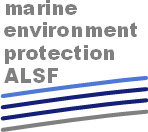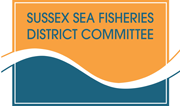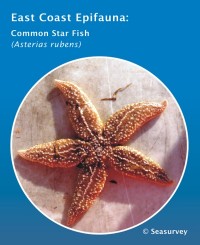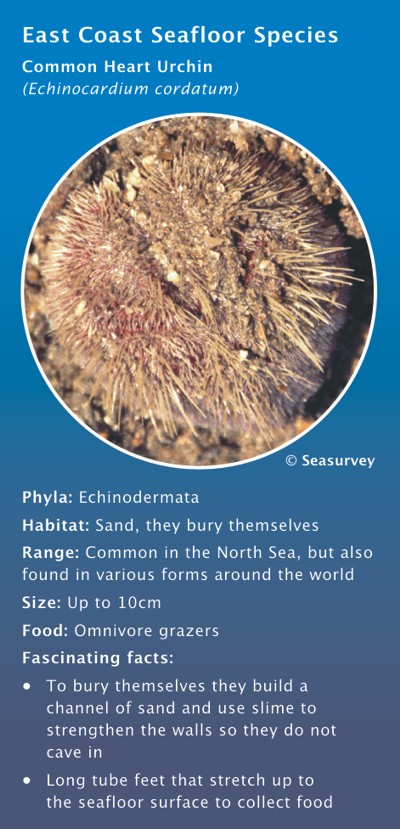Ecologists studied the animals living in and on the seafloor of the East Coast study area. It is important to know what species of animals and how many live in the region, as well as what habitat they like to live in, so that we can protect our amazing coastal sea life.
The focus of the REC ecology research was studying the benthic macrofauna. This term refers to all small animals that live in and on the seafloor.
Ecologists divide the benthic macrofauna into two main groups. Infauna are animals that live in the seafloor, buried in the sediment. Epifauna live on or just above the seafloor, normally when there is gravel or rocky areas that the animals can attach to.
They also studied other larger mobile animals, like fish, which live on the seafloor.
 The East Coast REC Ecology Results
The East Coast REC Ecology Results
This section provides a summary of the East Coast REC results for the ecological research.
Click on the links below to find out about each topic, or scroll down to read the entire text.
- What is living in the seafloor?
- What is living on the seafloor?
- Seafloor communities
- Seafloor species: Common heart urchin
You can find out more about the scientific research techniques mentioned in the sections below by visiting the “How we study the seafloor” webpages.
Read our Sustainability webpages to discover how these results will help protect the East Coast REC area.
[jwplayer mediaid=”3883″]
Unless stated otherwise all sea animal images © Seasurvey; other images © Crown copyright
What is living in the seafloor?
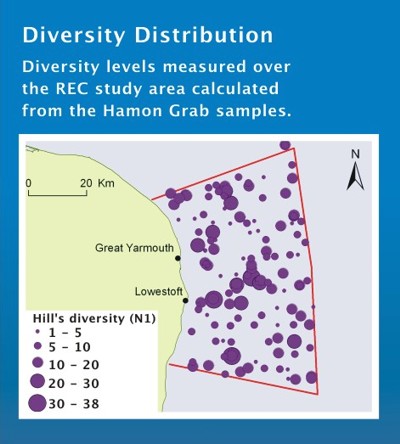 During the REC, ecologists discovered that there are many different animals living in the East Coast seafloor.
During the REC, ecologists discovered that there are many different animals living in the East Coast seafloor.
Working from a boat, the ecologists used a Hamon Grab to collect 158 samples of infauna to study. It is important to note that the Hamon Grab will also collect some epifauna, animals that live on the seafloor too, so often the results contain both epifauna and infauna species. In total, the ecologists discovered 391 different types of benthic macrofauna.
The ecologists identified combinations or patterns of animals living together from the information they collected. They discovered 14 different groups that like to live in different environments.
First, they recorded the infauna by animal types. The most common animal type in the East Coast was the Annelida, which is a term that describes most marine worms.
Each animal type, known as phyla, is made up of lots of different species, for example, the Ross worm and the T-headed worm are both Annelida.
The ecologists found that the diversity – the number of different species living in one place – was relatively low around the East Coast area. Most samples consisted of less than 17 different animals. Can you work out where the biodiversity is highest, from the map?
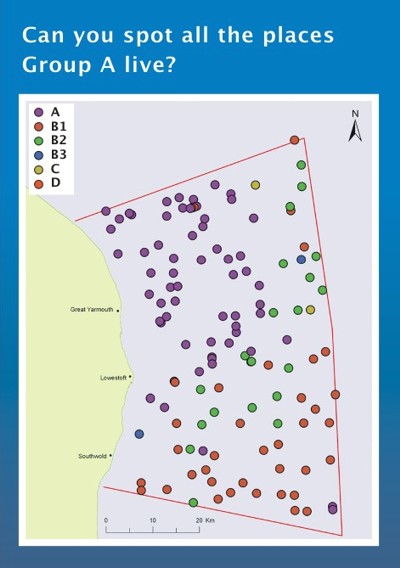 What is living on the seafloor?
What is living on the seafloor?
Using trawling nets along the seafloor is another method for exploring marine life. Ecologists used this method when they studied the East Coast seafloor.
The beam trawl collected 127 samples of epifauna and demersal fish for the ecologists to study. It is important to note that the Beam Trawl will also collect some infauna so often the results contain both epifauna and infauna species. In total, the ecologists discovered 130 different types of benthic macrofauna.
The most common animal type from the trawl samples was Echinodermata.
Ecologists discovered low numbers of sea animal in samples taken from the centre of the north half of the East Coast region, compared to the rest of the study area. This suggests that this area is not an ideal habitat for sea animals.
The hermit crab turned up the most in samples, collected in 123 out of a total of 127 trawls.
Again, ecologists looked for different combinations of animals that live together out of the larger epifanua. This time they found 13 groups, named A to M. For example, Group A includes brown shrimp, hermit crabs and the common starfish and is notable for not having any brittlestars, which are common elsewhere. This group did not have a single preferred habitat; they lived in a variety of habitat types.
Seafloor communities
Different combinations of animals and plants like to live in different underwater environments. We can think of these groups of animal and plants as seafloor communities.
[jwplayer mediaid=”3888″]
Understanding seafloor communities and their habitats is important to help us protect sea life in the East Coast area and all around the coasts of the United Kingdom.
By gathering together information about seafloor animals and the geology for the area, ecologists are able to map the seafloor communities and their habitats.
This is a complicated process called modelling, which uses computer programs to help predict how the results from our samples stations can tell us about the whole area. This is needed because it is not possible to take grab or trawl samples from everywhere in the study area and we need to fill in the gaps. You can find out more in our methods webpage.
Ecologists give each seafloor community and its habitat a classification called a biotope, which provides a description of its key components.
This biotope system allows us to predict areas of the seafloor where endangered species live, or where diversity is high, so that we can ensure they are protected. We can also keep an eye on these areas, to see how changes caused by humans or nature affect the numbers and types of animals present.
Seafloor species: Common heart urchin

